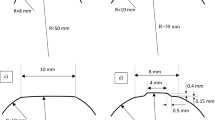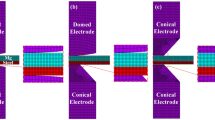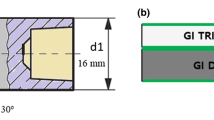Abstract
The present work studied the influence of the geometric design of the electrode on Zn-assisted liquid metal embrittlement (LME) cracking during resistance spot welding (RSW). LME cracking of the galvannealed transformation-induced plasticity (TRIP) steel welds, induced by two types of electrodes, a radius type with different radius of curvature (R), and a dome type with variable tip diameter (d), was studied both experimentally and by simulation. The current density decreased and the contact area at the electrode/sheet (E/S) interface increased with the increasing R, resulting in low temperatures and thermal stress, which subsequently led to decreased LME tendency. On the contrary, the current density decreased but the initial contact area at the E/S interface remained unchanged with increasing d, causing only a minor reduction in the temperature and hence less influence on LME cracking. These results suggested that R is the most critical design parameter of the electrode that controls LME cracking. Moreover, the radius type electrode displayed lower LME sensitivity as compared with the dome type electrode. This is attributed to the fact that the radius type electrode provides the benefits of increase in both R and d.





















Similar content being viewed by others
References
Pouranvari M, Marashi SPH (2013) Critical review of automotive steels spot welding: process, structure and properties. Sci Technol Weld Join 18:361–403. https://doi.org/10.1179/1362171813Y.0000000120
Seo JC, Choi ID, Son HR, Ji C, Kim C, Suh SB, Seo J, Park YD (2015) A comparative study of constant current control and adaptive control on electrode life time for resistance spot welding of galvanized steels. J Weld Join 33:47–55
Chang IS, Cho YJ, Park HS, So DY (2016) Importance of fundamental manufacturing technology in the automotive industry and the state of the art welding and joining technology. J Weld Join 34:21–25. https://doi.org/10.5781/JWJ.2016.34.1.21
Ji C, Park C, Kim C, Cho Y, Oh D, Kim MH, Kim YD, Park YD (2017) A comparative study of weldable current range on AC and MFDC resistance spot welding for 440 MPa grade steel sheet. J Weld Join 35:34–42. https://doi.org/10.5781/JWJ.2017.35.1.34
Jenney CL, O’Brien A (1991) Welding handbook: Welding Processes (Part-2), 9th edn. American Welding Society (AWS), Miami
Zhang H, Senkara J (2017) Resistance welding: fundamentals and applications, 2nd edn. CRC Press, Taylor & Francis Group, Boca Raton
Resistance Welding Manufacturing Alliance (2003) Resistance Welding Manual, 4th edn. American Welding Society (AWS), Philadelphia
Marder AR (2000) Metallurgy of zinc-coated steel. Prog Mater Sci 45:191–271. https://doi.org/10.1016/S0079-6425(98)00006-1
Tumuluru M (2007) The effect of coatings on the resistance spot welding behavior of 780 MPa dual-phase steel. Weld J 86:161–169
Parker JD, Williams NT, Holliday RJ (1998) Mechanisms of electrode degradation when spot welding coated steels. Sci Technol Weld Join 3:65–74. https://doi.org/10.1179/stw.1998.3.2.65
Ashiri R, Haque MA, Ji CW, shamanian M, Salimijazi HR, Park YD (2015) Supercritical area and critical nugget diameter for liquid metal embrittlement of Zn-coated twining induced plasticity steels. Scr Mater 109:6–10. https://doi.org/10.1016/j.scriptamat.2015.07.006
Ashiri R, Shamanian M, Salimijazi HR, Haque MA, Bae JH, Ji CW, Chin KG, Park YD (2016) Liquid metal embrittlement-free welds of Zn-coated twinning induced plasticity steels. Scr Mater 114:41–47. https://doi.org/10.1016/j.scriptamat.2015.11.027
Ling Z, Wang M, Kong L (2018) Liquid metal embrittlement of galvanized steels during industrial processing: a review. In: Trans. Intell. Weld. Manuf. pp 25–42
Bhattacharya D (2018) Liquid metal embrittlement during resistance spot welding of Zn-coated high-strength steels. Mater Sci Technol 1–21. https://doi.org/10.1080/02670836.2018.1461595
Kim YG, Kim IJ, Kim JS, Chung YI, Choi DY (2014) Evaluation of surface crack in resistance spot welds of Zn-coated steel. Mater Trans 55:171–175. https://doi.org/10.2320/matertrans.M2013244
DiGiovanni C, Han X, Powell A, Biro E, Zhou NY (2019) Experimental and numerical analysis of liquid metal embrittlement crack location. J Mater Eng Perform 28:2045–2052. https://doi.org/10.1007/s11665-019-04005-2
Wintjes E, DiGiovanni C, He L, Biro E, Zhou NY (2019) Quantifying the link between crack distribution and resistance spot weld strength reduction in liquid metal embrittlement susceptible steels. Weld World 63:807–814. https://doi.org/10.1007/s40194-019-00712-5
DiGiovanni C, Biro E, Zhou NY (2019) Impact of liquid metal embrittlement cracks on resistance spot weld static strength. Sci Technol Weld Join 24:218–224. https://doi.org/10.1080/13621718.2018.1518363
Takashima K, Sawanishi C, Taniguchi K et al (2017) Development of resistance spot welding technology to suppress LME crack in ultra high strength steel sheets. Prepr Natl Meet JWS. https://doi.org/10.14920/jwstaikai.2017s.0_16
Barthelmie J, Schram A, Wesling V (2016) Liquid metal embrittlement in resistance spot welding and hot tensile tests of surface-refined TWIP steels. IOP Conf Ser Mater Sci Eng 118:012002. https://doi.org/10.1088/1757-899X/118/1/012002
Aa EM Van Der, Hanlon DN, Veldt T Van Der (2017) Resistance spot weldability of 3rd generation advanced high strength steels for automotive applications. Steels Cars Truck. Conf
Sierlinger R, Gruber M (2017) A cracking good story about liquid metal embrittlement during spot welding of advanced high strength steels. Join. Car Body Eng
Zhang H, Senkara J, Wu X (2002) Suppressing cracking in resistance welding AA5754 by mechanical means. J Manuf Sci Eng 124:79. https://doi.org/10.1115/1.1418693
Goodwin EF, Silva AE (2017) Current topics and priorities in forming and joining of advanced galvanized sheet steels. Int Conf Zinc Zinc Alloy Coat. Steel Sheet
Lippold JC, Baeslack WA, Varol I (1992) Heat-affected zone liquation cracking in austenitic and duplex stainless steels. Weld Res Suppl 1–14
Wolski K, Laporte V (2008) Grain boundary diffusion and wetting in the analysis of intergranular penetration. Mater Sci Eng A 495:138–146. https://doi.org/10.1016/J.MSEA.2007.10.107
Zhang W (2003) Design and implementation of software for resistance welding process simulations. SAE Int J Mater Manuf 105–113. https://doi.org/10.4271/2003-01-0978
Zhang W (2012) Recent advances and improvements in the simulation of resistance welding processes. Weld World 50:29–37. https://doi.org/10.5772/2884
American Welding Society (2012) AWS D8.9M:2012-Recommended Practices for Test Methods for Evaluating the Resistance Spot Welding Behavior of Automotive Sheet Steel Materials. American Welding Society, Miami
Bowers R, Sorensen C, Eagar T (1990) Electrode geometry in resistance spot welding. Weld J 45–51
Li Y, Wei Z, Li Y, Shen Q, Lin ZQ (2013) Effects of cone angle of truncated electrode on heat and mass transfer in resistance spot welding. Int J Heat Mass Transf 65:400–408. https://doi.org/10.1016/j.ijheatmasstransfer.2013.06.012
Kimchi M (1984) Spot weld properties when welding with expulsion- a comparative study. Weld Res Suppl:58–63
Tuchtfeld M, Heilmann S, Füssel U, Jüttner S (2019) Comparing the effect of electrode geometry on resistance spot welding of aluminum alloys between experimental results and numerical simulation. Weld World 63:527–540. https://doi.org/10.1007/s40194-018-00683-z
Frei J, Rethmeier M (2018) Susceptibility of electrolytically galvanized dual-phase steel sheets to liquid metal embrittlement during resistance spot welding. Weld World 62:1031–1037. https://doi.org/10.1007/s40194-018-0619-1
Tarimer I, Arslan S, Emin Güven M, Karabaş M (2011) A case study of a new spot welding electrode which has the best current density by magnetic analysis solutions. J Electr Eng 62:233–238. https://doi.org/10.2478/v10187-011-0037-8
Funding
This work was supported by the Korea Basic Science Institute (KBSI) National Research Facilities & Equipment Center (NFEC) grant funded by the Ministry of Education, Korea government (No. 2019R1A6C1010045).
Author information
Authors and Affiliations
Corresponding author
Additional information
Publisher’s note
Springer Nature remains neutral with regard to jurisdictional claims in published maps and institutional affiliations.
Recommended for publication by Commission III - Resistance Welding, Solid State Welding, and Allied Joining Process
Rights and permissions
About this article
Cite this article
Murugan, S.P., Mahmud, K., Ji, C. et al. Critical design parameters of the electrode for liquid metal embrittlement cracking in resistance spot welding. Weld World 63, 1613–1632 (2019). https://doi.org/10.1007/s40194-019-00797-y
Received:
Accepted:
Published:
Issue Date:
DOI: https://doi.org/10.1007/s40194-019-00797-y




